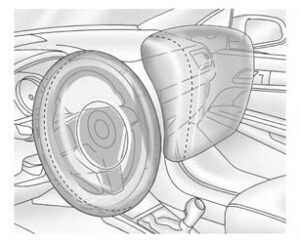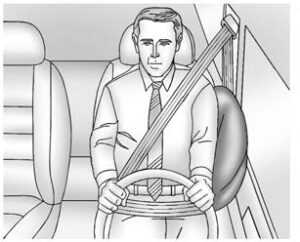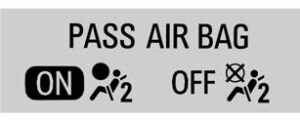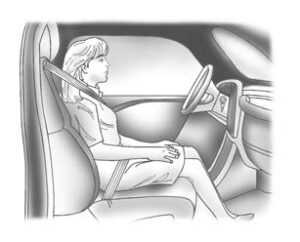2023 Cadillac CT5 Airbag Features Guide
The 2023 Cadillac CT5 places a strong emphasis on safety, and its cutting-edge Airbag Features Guide, which incorporates the ground-breaking Passenger Sensing System and Airbag System Check, is at the heart of its dedication to occupant protection. With this extensive safety package, you can be sure that every ride is protected by state-of-the-art systems that adapt to the needs of the car’s occupants. Let’s examine the characteristics that set the 2023 CT5 apart in the airbag department.
The Passenger Sensing System on the 2023 Cadillac CT5 is the epitome of sophisticated safety technology. By utilizing sophisticated sensors, this technology can recognize and identify the person in the front seat. Through a thorough analysis of variables including weight and seating position, the technology dynamically adjusts the airbags’ deployment parameters. With this adaptive technique, airbags are activated with the exact force needed to provide tailored safety for passengers of different sizes and positions.
2023 Cadillac CT5 Specs, Price, Features, Mileage and Review
2023 Cadillac CT5 Airbag Owners Manual
Airbag System
The vehicle has the following airbags:
- A frontal airbag for the driver
- A frontal airbag for the front outboard passenger
- A knee airbag for the driver
- A front centre airbag for the driver and front outboard passenger
- A seat-mounted side impact airbag for the driver
- A seat-mounted side impact airbag for the front outboard passenger
- A roof-rail airbag for the driver and the second and third-row passengers seated directly behind the driver
- A roof-rail airbag for the front outboard passenger and the second and third-row passengers seated directly behind the front outboard passenger
Airbag System Guide
All vehicle airbags have the word AIRBAG on the trim or a label near the deployment opening. For frontal airbags, the word AIRBAG is on the centre of the steering wheel for the driver and on the instrument panel for the front outboard passenger. For knee airbags, the word AIRBAG is on the lower part of the instrument panel. For the front centre airbag, the word AIRBAG is on the inboard side of the driver seatback.
For seat-mounted side impact airbags, the word AIRBAG is on the side of the seatback or the side of the seat closest to the door. For roof-rail airbags, the word AIRBAG is on the ceiling or trim. Airbags are designed to supplement the protection provided by seat belts. Even though today’s airbags are also designed to help reduce the risk of injury from the force of an inflating bag, all airbags must inflate very quickly to do their job.
Automotive Safety Features
Here are the most important things to know about the airbag system:
Warning
- You can be severely injured or killed in a crash if you are not wearing your seat belt, even with airbags. Airbags are designed to work with seat belts, not replace them. Also, airbags are not designed to inflate in every crash. In some crashes, seat belts are the only restraint. See When Should an Airbag Inflate? 0 54.
Wearing your seat belt during a crash helps reduce your chance of hitting things inside the vehicle or being ejected from it. Airbags are “supplemental restraints” to seat belts. Everyone in the vehicle should wear a seat belt properly, whether or not there is an airbag for that person. - Because airbags inflate with great force and faster than the blink of an eye, anyone who is up against, or very to any airbag when it inflates can be seriously injured or killed. Do not sit unnecessarily close to any airbag, as you would be if sitting on the edge of the seat or leaning forward. Seat belts help keep you in position before and during a crash. Always wear a seat belt, even with airbags. The driver should sit as far back as possible while still maintaining control of the vehicle. The seat belts and the front outboard passenger airbags are most effective when you are sitting well back and upright in the seat with both feet on the floor.
- Occupants should not lean on or sleep against the front centre armrest or console in vehicles with a front centre airbag.
- Occupants should not lean on or sleep against the door or side windows in seating positions with seat-mounted side impact airbags and/or roof-rail airbags.
- Children who are up against, or very close to, any airbag when it inflates can be seriously injured or killed. Always secure children properly in the vehicle. To read how see Older Children 0 61 or Infants and Young Children 0 63.
- There is an airbag readiness light on the instrument cluster, which shows the airbag symbol.
- The system checks the airbag’s electrical system for malfunctions. The light tells you if there is an electrical problem. See Airbag Readiness Light 0 98.
Where Are the Airbags?
 The driver’s frontal airbag is in the centre of the steering wheel.
The driver’s frontal airbag is in the centre of the steering wheel.
The front outboard passenger frontal airbag is in the passenger side instrument panel The driver’s knee airbag is below the steering column. The front outboard passenger knee airbag is below the glove box
The driver’s knee airbag is below the steering column. The front outboard passenger knee airbag is below the glove box

Driver Side Shown, Passenger Side Similar
The seat-mounted side impact airbags for the driver and front outboard passenger are on the sides of the seatbacks closest to the door.
Driver Side Shown, Passenger Side Similar
The roof-rail airbags for the driver, front outboard passenger and second and third-row outboard passengers are in the ceiling above the side windows.
2023 Cadillac CT5 Airbag User Manual
Warning
- If something is between an occupant and an airbag, the airbag might not inflate properly or it might force the object into that person causing severe injury or even death. The path of an inflating airbag must be kept clear. Do not put anything between an occupant and an airbag, and do not attach or put anything on the steering wheel hub or on or near any other airbag covering.
- Do not use seat or console accessories that block the inflation path of a seat-mounted side impact airbag or the front centre airbag.
Never secure anything to the roof of a vehicle with roof-rail airbags by routing a rope or tie-down through any door or window opening. If you do, the path of an inflating roof-rail airbag will be blocked.
Vehicle Safety Technology
When Should an Airbag Inflate?
This vehicle is equipped with airbags. See Airbag System 0 54. Airbags are designed to inflate if the impact exceeds the specific airbag system’s deployment threshold. Deployment thresholds are used to predict how severe a crash is likely to be in time for the airbags to inflate and help restrain the occupants. The vehicle has electronic sensors that help the airbag system determine the severity of the impact. Deployment thresholds can vary with specific vehicle designs.
Frontal airbags are designed to inflate in moderate to severe frontal crashes to help reduce the potential for severe injuries, mainly to the driver’s or front outboard passenger’s head and chest.
Whether the frontal airbags will or should inflate is not based primarily on how fast the vehicle is travelling. It depends on what is hit, the direction of the impact, and how quickly the vehicle slows down. Frontal airbags may inflate at different crash speeds depending on whether the vehicle hits an object straight on or at an angle, and whether the object is fixed or moving, rigid or deformable, narrow or wide. Frontal airbags are not intended to inflate during vehicle rollovers, in rear impacts, or many side impacts. In addition, the vehicle has advanced technology frontal airbags. Advanced technology frontal airbags adjust the restraint according to crash severity. Knee airbags are designed to inflate in moderate to severe frontal impacts. Knee airbags are not designed to inflate during vehicle rollovers, in rear impacts, or many side impacts.
The front center airbag is designed to inflate in moderate to severe side crashes depending on the location of the impact, when either side of the vehicle is struck. In addition, the front centre airbag is designed to inflate when the sensing system predicts that the vehicle is about to roll over on its side. The front centre airbag is not designed to inflate in frontal impacts, near frontal impacts, or rear impacts. Seat-mounted side impact airbags are designed to inflate in moderate to severe side crashes depending on the location of the impact. These airbags may also inflate in some moderate to severe frontal impacts.
Seat-mounted side impact airbags are not designed to inflate in rollovers or rear impacts. A seat-mounted side impact airbag is designed to inflate on the side of the vehicle that is struck.
Roof-rail airbags are designed to inflate in moderate to severe side crashes depending on the location of the impact. In addition, these roof-rail airbags may inflate during a rollover or in a severe frontal impact. Roof-rail airbags are not designed to inflate in rear impacts. Both roof-rail airbags may inflate when either side of the vehicle is struck or if the sensing system predicts that the vehicle is about to roll over on its side, or in a severe frontal impact.
In any particular crash, no one can say whether an airbag should have inflated simply because of the vehicle damage or repair costs.
What Makes an Airbag Inflate?
In a deployment event, the sensing system sends an electrical signal triggering a release
of gas from the inflator. Gas from the inflator fills the airbag causing the bag to break out of the cover. The inflator, the airbag, and related hardware are all part of the airbag module. For airbag locations, see Where Are the Airbags? 53.
How Does an Airbag Restrain?
In moderate to severe frontal or near frontal collisions, even belted occupants can contact the steering wheel or the instrument panel.
In moderate to severe side collisions, even belted occupants can contact the inside of the vehicle.
Airbags supplement the protection provided by seat belts by distributing the force of the impact more evenly over the occupant’s body.
Rollover-capable roof-rail airbags are designed to help contain the head and chest of occupants in the outboard seating positions in the first, second, and third rows.
The rollover-capable roof-rail airbags are designed to help reduce the risk of full or partial ejection in rollover events, although no system can prevent all such ejections. However, airbags would not help in many types of collisions, primarily because the occupant’s motion is not toward those airbags. See When Should an Airbag Inflate? 54. Airbags should never be regarded as anything more than a supplement to seat belts.
What Will You See After an Airbag Inflates?
After frontal, knee, and seat-mounted side impact airbags inflate, they quickly deflate, so quickly that some people may not even realize the airbags are inflated. The front centre airbag and roof-rail airbags may still be at least partially inflated for some time after they inflate. Some components of the airbag module may be hot for several minutes. For the location of the airbags, see Where Are the Airbags? 53.
The parts of the airbag that come into contact with you may be warm, but not too hot to touch. There may be some smoke and dust coming from the vents in the deflated airbags. Airbag inflation does not prevent the driver from seeing out of the windshield or being able to steer the vehicle, nor does it prevent people from leaving the vehicle.
Warning
- When an airbag inflates, there may be dust in the air. This dust could cause breathing problems for people with a history of asthma or other breathing trouble. To avoid this, everyone in the vehicle should get out as soon as it is safe to do so. If you have breathing problems but cannot get out of the vehicle after an airbag inflates, then get fresh air by opening a window or a door. If you experience breathing problems following an airbag deployment, you should seek medical attention.
- The vehicle has a feature that may automatically unlock the doors, turn on the interior lamps and hazard warning flashers, and shut off the fuel system after the airbags inflate. The feature may also activate, without airbag inflation, after an event that exceeds a predetermined threshold. After turning the ignition off and then on again, the fuel system will return to normal operation; the doors can be locked, the interior lamps can be turned off, and the hazard warning flashers can be turned off using the controls for those features. If any of these systems are damaged in the crash they may not operate as normal.
- A crash severe enough to inflate the airbags may have also damaged important functions in the vehicle, such as the fuel system, brake and steering systems, etc. Even if the vehicle appears to be drivable after a moderate crash, there may be concealed damage that could make it difficult to safely operate the vehicle.
Use caution if you should attempt to restart the engine after a crash has occurred.
2023 Cadillac CT5 Airbag User Guide
In many crashes, severe enough to inflate the airbag, windshields are broken by vehicle deformation. Additional windshield breakage may also occur from the front outboard passenger airbag.
- Airbags are designed to inflate only once.
After an airbag inflates, you will need some new parts for the airbag system.
If you do not get them, the airbag system will not be there to help protect you in another crash. A new system will include airbag modules and possibly other parts. The service manual for the vehicle covers the need to replace other parts. - The vehicle has a crash-sensing and diagnostic module which records information after a crash. See Vehicle Data Recording and Privacy 0 360 and
Event Data Recorders 0 361. - Let only qualified technicians work on the airbag systems. Improper service can mean that an airbag system will not work properly. See your dealer for service.
Advanced Airbag System
Passenger Sensing System
The vehicle has a passenger sensing system for the front outboard passenger position.
The passenger airbag status indicator will light on the overhead console when the vehicle is started.
The words ON and OFF, and the symbols for on and off, will be visible during the system check. When the system check is complete, either the word ON or OFF, and the symbol for on or off, will be visible. See Passenger Airbag Status Indicator .0 99.
The passenger sensing system turns off the front outboard passenger frontal airbag under certain conditions. No other airbag is affected by the passenger sensing system. The passenger sensing system works with sensors that are part of the front outboard passenger seat and seat belt. The sensors are designed to detect the presence of a properly seated occupant and determine if the front outboard passenger frontal airbag should be allowed to inflate or not.
According to accident statistics, children are safer when properly secured in a rear seat in the correct child restraint for their weight and size.
Whenever possible, children aged 12 and under should be secured in a rear seating position.
Never put a rear-facing child seat in the front. This is because the risk to the rear-facing child is so great if the airbag inflates.
Warning
- A child in a rear-facing child restraint can be seriously injured or killed if the passenger frontal airbag inflates. This is because the back of the rear-facing child restraint would be very close to the inflating airbag. A child in a forward-facing child restraint can be seriously injured or killed if the passenger frontal airbag inflates and the passenger seat is in a forward position.
- Even if the passenger sensing system has turned off the passenger frontal airbag, no system is fail-safe. No one can guarantee that an airbag will not deploy under some unusual circumstance, even though the airbag is turned off. Never put a rear-facing child restraint in the front seat, even if the airbag is off.
- If securing a forward-facing child restraint in the front outboard passenger seat, always move the seat as far back as it will go. It is better to secure child restraints in the rear seat. Consider using another vehicle to transport the child when a rear seat is not available.
The passenger sensing system is designed to turn off the front outboard passenger frontal airbag if:
- The front outboard passenger seat is unoccupied.
- The system determines an infant is present in a child restraint.
- A front-outboard passenger takes his/her weight off of the seat for a while.
- There is a critical problem with the airbag system or the passenger sensing system.
When the passenger sensing system has turned off the front outboard passenger frontal airbag, the OFF indicator will light and stay lit as a reminder that the airbag is off. See Passenger Airbag Status Indicator 99. The passenger sensing system is designed to turn on the front outboard passenger frontal airbag anytime the system senses that a person of adult size is sitting properly in the front outboard passenger seat.
When the passenger sensing system has allowed the airbag to be enabled, the ON indicator will light and stay lit as a reminder that the airbag is active.
For some children, including children in child restraints, and very small adults, the passenger sensing system may or may not turn off the front outboard passenger frontal airbag, depending upon the person’s seating posture and body build. Everyone in the vehicle who has outgrown child restraints should wear a seat belt properly — whether or not there is an airbag for that person.
Warning
If the airbag readiness light ever comes on and stays on, it means that something may be wrong with the airbag system. To help avoid injury to yourself or others, have the vehicle serviced right away. See Airbag Readiness Light 0 104 for more information, including important safety information.
If the On Indicator Is Lit for a Child Restraint
The passenger sensing system is designed to turn off the front outboard passenger frontal airbag if the system determines that an infant is present in a child restraint.
If a child restraint has been installed and the ON indicator is lit:
- Turn the vehicle off.
- Remove the child restraint from the vehicle.
- Remove any additional items from the seat such as blankets, cushions, seat covers, seat heaters, or seat massagers.
- Reinstall the child restraint following the directions provided by the child restraint manufacturer and refer to Securing Child Restraints (With the Seat Belt in the Rear Seat) 0 74 or Securing Child Restraints (With the Seat Belt in the Front Seat)76
Make sure the seat belt retractor is locked by pulling the shoulder belt out of the retractor when installing the child restraint, even if the child restraint is equipped with a seat belt lock-off. When the retractor lock is set, the belt can be tightened but not pulled out of the retractor. - If, after reinstalling the child restraint and restarting the vehicle, the ON indicator is still lit, turn the vehicle off. Then slightly recline the vehicle seatback and adjust the seat cushion, if adjustable, to make sure that the vehicle seatback is not pushing the child restraint into the seat cushion. Also, make sure the child restraint is not trapped under the vehicle head restraint. If this happens, adjust the head restraint 33.
- Restart the vehicle.
The passenger sensing system may or may not turn off the airbag for a child in a child restraint depending upon the child’s size.
It is better to secure the child restraint in a rear seat. Never put a rear-facing child restraint in the front seat, even if the ON indicator is not lit.
If the Off Indicator Is Lit for an Adult-Sized Occupant
If a person of adult size is sitting in the front outboard passenger seat, but the OFF indicator is lit, it could be because that person is not sitting properly in the seat or that the child restraint locking feature is engaged. Use the following steps to allow the system to detect that person and enable the front outboard passenger frontal airbag:
- Turn the vehicle off.
- Remove any additional material from the seat, such as blankets, cushions, seat covers, seat heaters, or seat massagers.
- Place the seatback in the fully upright position.
- Have the person sit upright in the seat, centred on the seat cushion, with legs comfortably extended.
- If the shoulder portion of the belt is pulled out all the way, the child restraint locking feature will be engaged. This may unintentionally cause the passenger sensing system to turn the airbag off for some adult-sized occupants. If this happens, unbuckle the belt, let the belt go back all the way, and then buckle the belt again without pulling the belt out
all the way. - Restart the vehicle and have the person remain in this position for two to three minutes after the ON indicator is lit.
Warning
If the front outboard passenger airbag is turned off for an adult-sized occupant, the airbag will not be able to inflate and help protect that person in a crash, resulting in an increased risk of serious injury or even death. An adult-sized occupant should not ride in the front outboard passenger seat if the passenger airbag OFF indicator is lit.
Additional Factors Affecting System Operation
Seat belts help keep the passenger in position on the seat during vehicle manoeuvres and braking, which helps the passenger sensing system maintain the passenger airbag status. See “Seat Belts” and “Child Restraints” in the Index for additional information about the importance of proper restraint use.
A thick layer of additional material, such as a blanket or cushion, or aftermarket equipment such as seat covers, seat heaters, and seat massagers can affect how well the passenger sensing system operates. We recommend that you not use seat covers or other aftermarket equipment except when approved by GM for your specific vehicle. See Adding Equipment to the Airbag-Equipped Vehicle 0 63 for more information about modifications that can affect how the system operates.
The ON indicator may be lit if an object, such as a briefcase, handbag, grocery bag, laptop, or another electronic device, is put on an unoccupied seat. If this is not desired, remove the object from the seat.
Warning
Stowing articles under the passenger seat or between the passenger seat cushion and seatback may interfere with the proper operation of the passenger sensing system.
Servicing the Airbag-Equipped Vehicle
Airbags affect how the vehicle should be serviced. There are parts of the airbag system in several places around the vehicle. Your dealer and the service manual have information about servicing the vehicle and the airbag system. To purchase a service manual, see Publication Ordering Information 0 390.
Warning
For up to 10 seconds after the vehicle is turned off and the battery is disconnected, an airbag can still inflate during improper service. You can be injured if you are close to an airbag when it inflates. Avoid yellow connectors. They are probably part of the airbag system. Be sure to follow proper service procedures, and make sure the person performing work for you is qualified to do so.
Adding Equipment to the Airbag-Equipped Vehicle
Adding accessories that change the vehicle’s frame, bumper system, height, front end, or side sheet metal may keep the airbag system from working properly.
The operation of the airbag system can also be affected by changing, including improperly repairing or replacing, any parts of the following:
- Airbag system, including airbag modules, front or side impact sensors, sensing, and diagnostic modules, airbag wiring, or front
center console - Front seats, including stitching, seams or zippers
- Seat belts
- Steering wheel, instrument panel, overhead console, ceiling trim, or pillar garnish trim
- Inner door seals, including speakers Your dealer and the service manual, have information about the location of the airbag modules and sensors, sensing and diagnostic module, and airbag wiring along with the proper replacement procedures.
In addition, the vehicle has a passenger sensing system for the front outboard passenger position, which includes sensors that are part of the passenger’s seat. The passenger sensing system may not operate properly if the original seat trim is replaced with non-GM covers, upholstery, or trim, or with GM covers, upholstery, or trim designed for a different vehicle. Any object, such as an aftermarket seat heater or a comfort-enhancing pad or device, installed under or on top of the seat fabric, could also interfere with the operation of the passenger sensing system. This could either prevent proper deployment of the passenger airbag(s) or prevent the passenger sensing system from properly turning off the passenger airbag(s). See Passenger Sensing System 056.
If the vehicle has rollover roof-rail airbags, see Different Size tyres and Wheels 0 308 for additional important information.
If the vehicle must be modified because you have a disability and you have questions about whether the modifications will affect the vehicle’s airbag system, or if you have questions about whether the airbag system will be affected if the vehicle is modified for any other reason, call Customer Assistance. See Customer Assistance Offices 384.
Airbag System Check
The airbag system does not need regularly scheduled maintenance or replacement. Make sure the airbag readiness light is working. See Airbag Readiness Light 0 104.
Caution
If an airbag covering is damaged, opened, or broken, the airbag may not work properly. Do not open or break the airbag coverings. If there are any opened or broken airbag coverings, have the airbag covering and/or airbag module replaced. For the location of the airbags, see Where Are the Airbags? 53.
Replacing Airbag System Parts after a Crash
Warning
A crash can damage the airbag systems in the vehicle. A damaged airbag system may not properly protect you and your passenger(s) in a crash, resulting in serious injury or even death. To help make sure the airbag systems are working properly after a crash, have them inspected and any necessary replacements made as soon as possible.
If an airbag inflates, you will need to replace the airbag system parts. See your dealer for service. If the airbag readiness light stays on after the vehicle is started or comes on when you are driving, the airbag system may not work properly. Has the vehicle been serviced right away? See Airbag Readiness Light 98.
FAQS
The Airbag Features Guide is a set of integrated features designed to optimize the deployment and functionality of the vehicle’s airbag system for enhanced safety.
The Passenger Sensing System utilizes advanced sensors to detect the presence, weight, and seating position of the front-seat passenger. It dynamically adjusts airbag deployment parameters based on this analysis.
Yes, the system is designed to distinguish between occupants of varying sizes and positions, adjusting airbag deployment accordingly.
Typically, the system is active for the front-seat passenger, and its functionality may vary for other seating positions. Refer to the vehicle’s documentation for specific details.
The system is designed to operate automatically, and manual override may not be available to prevent misuse or tampering.
The Airbag System Check feature conducts routine diagnostic checks at regular intervals to ensure optimal working conditions.
The Airbag System Check evaluates various components of the airbag system, including sensors, modules, and deployment mechanisms, to ensure they are in optimal working condition.
In most cases, the Airbag System Check is conducted automatically by the vehicle. Manual initiation by the driver may not be necessary or available.
The system typically provides real-time feedback to the driver through the vehicle’s display or instrument cluster, indicating the status of the airbag system.
Depending on the vehicle’s design, the system may use visual or audible alerts to notify the driver if any issues are detected during the Airbag System Check.
Aftermarket modifications may impact the functionality of these systems. It is recommended to consult with the dealership or refer to the owner’s manual before making any modifications.
The Airbag System Check is designed to evaluate the entire airbag system, including side airbags and curtain airbags, to ensure comprehensive safety.
In the absence of a Passenger Sensing System reading, the airbag system is typically designed to deploy airbags with default parameters, providing a baseline level of protection.
The Airbag System Check is designed to evaluate various components, and depending on the vehicle’s design, it may include checks for seat belt pretensioners to ensure their proper functioning.
The recommended maintenance schedule for the Airbag System Check feature can be found in the vehicle’s documentation. Regular service intervals are typically suggested to ensure continued reliability and safety.
Useful Links
View Full User Guide: Cadillac CT5 2023 User Guide
Download Manuals: https://www.cadillac.com/support/vehicle/manuals-guides
Cadillac CT5 2023 Warning And Indicators User Guide
2023 Cadillac CT5 Specs, Price, Features, Mileage and Review


